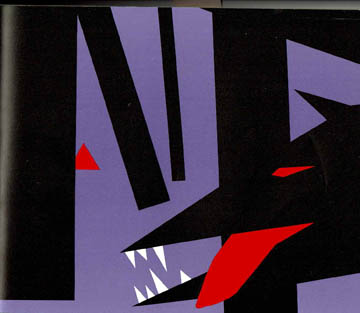
Another Daily Art challenge make. I am revisiting Red; I’m not alone, lots of people are seeing Red these days. There has to be a reason she is surfacing to consciousness right now. I’m not speaking for anybody else, but I feel two contrasting and contradictory energies at work currently. The illusion of black/white vs. ambiguity. The middle road seems very narrow these days. Mulder is back with his “question everything” philosophy. I like that; my feeling these days is that the questions are more worthwhile than the answers.
I started with the Rives BFK® printmaking paper and dropped some water randomly onto the surface. I put some black Dr. Martin’s® Bombay ink into the plain water drops and let it spread. I blew it around with just my breath and let it wander, then set it aside to dry.
I wanted to use tube watercolors today, so I picked up an ultramarine tube and kneaded it gently to mix the pigment up. These tubes are old so I go easy, but today not easy enough. I was daydreaming and looked down to find ultramarine watercolor all over my fingers. Luckily I had torn up a bunch of lunch sacks yesterday so I wiped my hands all over those pages, and everything else that wasn’t nailed down. Then I took a big brush and swiped water all over the paper to move the paint. I don’t want to think about how that will turn out when it dries, but can you say “CRINKLE?”
Well, watercolors dropped way down the list. That’s how easily I am deterred from stuff. I thought I might try ink. I have a mess of Higgins inks and I like them very much but I never have drawn with ink. I bought them for the purpose of making blot papers for my Interactive Intuitive Readings™ but they didn’t end up working as well as the Bombay ink. Higgins® Dye-based Drawing Inks are much less expensive and highly pigmented. The back of the package says they can be used like liquid watercolors.
I really like the way these inks move, and I would definitely equate them to watercolor nature. **Be advised, I have no watercolor or inking skills. I am purely at a “coloring book” level. If you want to investigate the qualities of either medium, consult someone else with a far greater proficiency.**
The black ink blot was dry so I started looking at it, spinning it around to see if anything presented itself. Here’s how I work with blots and expressive art. Take a couple of breaths, close eyes, open eyes, soften eyes, turn the paper. Pause. Turn paper, pause. Do this all the way around. Subconsciously you likely already ruled one orientation out. Keep going. Don’t get scared. There will be a point when you feel panic and think, “I don’t see anything!” That’s good and natural because this is a trust issue. Expressive art is about developing trust in your creativity and your instincts. Just breath again and keep going.
I went around several times. There was one other orientation that was intriguing and likely would have been deeper expression for me, but I do keep in mind my time limitation. I am sticking to my one hour religiously and sometimes that means sacrificing an idea or technique. That’s ok, there are always other opportunities. Two of the other images were already no go’s. Like it or not, this was the one remaining. Suddenly (and I mean that, like a bolt of lightning) the wolf appeared, really well defined. The major work back into the wolf shape was adding teeth and ears (he had a nub of ear originally). At this point, all I had was white paper, black blot and the red teeth and eye. As I was thinking and feeling what was left, I saw a curvy line that suggested Red’s Hood and Cape. You’ve got to be kidding me! So I colored that white space in with red. The image needed unity so I brushed on the dark blue for sky and green for ground. The other black blot is the silhouette of tree branch(es). I did see a snake head hanging down in mid-image so I outlined it lightly. It’s just a side note, but now we have three characters in our story.
So the image was nearly finished. There were the two white spots inside the wolf’s body, that is where the text could be. Text had to be short and handwritten. I got a toothpick and dipped it into the ink and scrawled it out.
I considered captioning it “Red’s Shadow.” That’s a black and white energy. I’m telling you the story. “Who’s the Wolf” is the ambiguous energy. Who is the wolf? Who is the innocent? Who is the onlooker? Who’s zoomin’ Who?
There was also the option to leave the space empty. The highest expression is to let you ask your own questions or the freedom to not ask any and move along. As the maker I am forcing you to do it my way.

